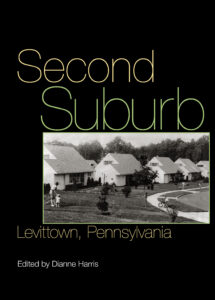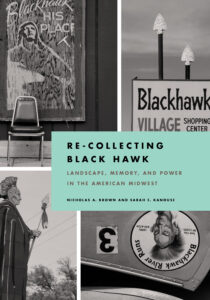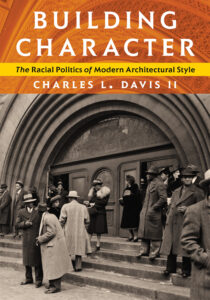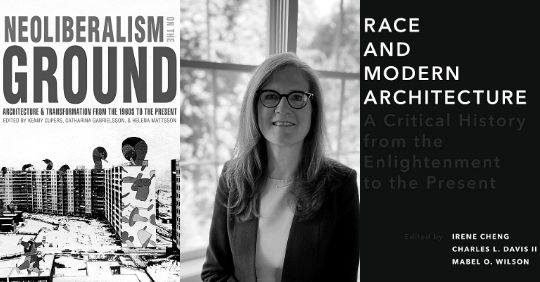Celebrating Ten Years of the Culture, Politics, and Built Environment Series: A Conversation with Series Editor Dianne Harris
Celebrating Ten Years of the Culture, Politics, and Built Environment Series: A Conversation with Series Editor Dianne Harris

Books in the Culture, Politics, and the Built Environment series address the intersecting relationships between the built environment and a range of cultural forces, exploring the ways buildings, cities, and landscapes impact—and are in turn shaped by—the formulation and function of deep social, economic, and political structures. They also examine the agency of the built environment as it actively helps to shape class, race, and gender identities. These books are notable for their innovative topics and approaches. The scope of the series is international and open to multidisciplinary work, but it is primarily focused on publishing spatial histories that have the potential to influence many other kinds of historical thought and writing.
In celebration of the ten year anniversary of CPBE, Acquiring Editor Abby Collier spoke with Series Editor Dianne Harris about the history and future of the series.
How did the series come about, and what inspired you to be part of it?
As a scholar, I’ve sought to understand the cultural consequences of space, and the spatial consequences of culture. That statement is a kind of shorthand I use to indicate my deeply held interest in understanding the ways the built forms and spaces we encounter, inhabit, in which we work, and through which we move, shape our understandings of who we are, of where we belong and from where we are excluded, of which opportunities are available and which are not, and the ways those are sometimes closely tied to survival. There are few truly enduring shared human experiences across time and space, but the spatial is one of them. Simply put, life takes place, but it doesn’t do so—now or in the past—in the absence of political and cultural structures and forces. All of us live every minute of our lives in spaces, most of which have been designed by someone. Understanding the relevance of those spaces and their histories to the cultural and political forces that shape lives—for better and for worse—seems to me essential if we are to more fully grasp nearly every grand challenge our planet now faces, from climate change to economic inequality to racial injustice (and the links among and between these) and beyond. As a scholar, I want to understand precisely those forces as they intersect with the histories of cities, buildings, landscapes, suburbs, and rural areas in order to get at a more complete, full, and accurate understanding of the past. As a series editor, I want to publish and promote the very best scholarship that does exactly this work.
It’s important to remember that the first book in the series appeared in 2010, but planning the series started in about 2003, and at a time when the fields of architectural and landscape history could not be characterized as those in which scholarship of the type I’ve just described was the norm. By this, I mean that the field until the twenty-first century remained predominantly, if not exclusively, one that examined questions of form and style with a strong focus on the roles played by well-known architects and designers who were overwhelmingly white and men. To be sure, strong countercurrents and counterexamples existed long before then, but suffice it to say that a focus on the political dimensions of the built environment, and scholarship that closely examined the role of buildings, landscapes, and urban spaces in the formation of cultural and especially political histories, existed in far less abundance than is now starting to be the case. Despite some outstanding scholarship produced by scholars like Dell Upton and many of his students, I keenly felt the absence of a more robust body of scholarship that might address the kinds of questions that most interested me, and that seemed of interest to a wider range of scholars and students. I also began to be in conversation with a then small but growing number of scholars whose interests intersected with my own, but for whom publishing opportunities were difficult to find. By the early 2000s I had a growing sense that the work was being produced, and that it could also be encouraged if a publishing venue existed to support this kind of scholarship, one that deliberately sought out this work and endeavored to produce books of the very highest caliber. And I believed that if we could publish a corpus of scholarship that followed from those ideas, that histories of the built environment could also reach audiences far beyond the fairly limited group of scholars who identify themselves as architectural, landscape, and urban historians. So, when the University of Pittsburgh Press approached me about a series, I jumped at the opportunity.
As such, my primary goals for the series are twofold: first, to bring outstanding new scholarship into the world that advances our understanding of the complex and manifold relationships that exist between the built environment and cultural and political histories; and second, to support and lift up the work of scholars whose work is not yet well known but who are positioned through their leading-edge work to reshape the ways we understand histories of architecture, landscapes, and cities by asking new, imaginative, and sometimes uncomfortable questions. That we’ve been able to publish many scholars’ first books, helping to launch the careers of some of the academy’s brightest minds, is also a source of real pride.
How has the series evolved over the past decade?
The series title was intentionally designed to be capacious enough to include a range of possible subjects so that authors could approach the theme variously. Knowing that we couldn’t yet imagine the directions new scholarship would take, we wanted the series title to be a provocative prompt rather than a tightly restricting delimitation. Having said that, we also wanted the series to cohere, and to have a real, rigorous, and overt focus on the politics of the built environment. The series has certainly evolved as it has grown, but it’s also interesting to see the ways several threads emerged and have continued to shape the series. At this stage of its life, I can identify at least five clear themes that we have cultivated in the series: a focus on architecture and nationalism/national identity formation; colonialism/postcolonialism and the built environment; political theories and the ways they shape the built world; control of the body and mind as a mechanism of politics and governmental control through architecture; and a focus on race and the built environment. All of these intersect and intertwine, and future series books are likely to pick up these threads, weaving them into new narratives even as it’s likely that race and decolonial histories may become a stronger focus.
For example, some of the earliest books in the series—those by Brigitte Le Normand (Designing Tito’s Capital, 2014), Emily Pugh (Architecture, Politics, and Identity in Divided Berlin, 2014), and Zeynep Kezer (Building Modern Turkey, 2015) focused primarily on various forms of nationalism as a force in the shaping of cities undergoing the turbulence of regime change. Kathryn O’Rourke’s Modern Architecture in Mexico City from 2016 likewise examined the connections between midcentury architectural modernism and the formation of a new understanding of nation in the Mexican capital city. That’s been one thread that runs through the series, but there are others as well. Colonialism is another, seen for example in two books that take very different approaches to that topic: Re-Collecting Blackhawk: Landscape, Memory, and Power in the American Midwest (2015) by Nicholas Brown and Sarah Kanouse, and Colonialism and Modern Architecture in Germany (2017) by Itohan Osayimwese. Postcolonialism and the politics of postwar housing in locales colonized by the forces of global capitalism became a related thread, seen in Farhan Karim’s book on housing design in India, Greater Dignity Than Riches (2019), and in Helen Gyger’s Improvised Cities (2019). Other works in the series examine specific theoretical constructs in collections of essays that aim to uncover the connection between (for example) Foucault’s theory of “governmentality” and the economy and politics of architecture in the twentieth century, as in 2012’s Governing By Design, assembled by the Aggregate Architectural History Collaborative, and more recently the deep dive into neoliberalism in the collection edited by Kenny Cupers, Catharina Gabrielsson, and Helena Mattsson in their 2020 volume, Neoliberalism on the Ground. And examinations of the body—particularly questions of hygiene and of psychology—as a means to understand connections between architecture, urbanism, governance, and control of bodies and minds—appear powerfully in the books by Sun-Young Park (Ideals of the Body, 2018), and by Joy Knoblauch (Architecture of Good Behavior, 2020).
My own scholarship has long focused on race and the built environment. We launched the series with a book I edited that had a strong focus on that topic (more on that just below), and two of the most recently published books in the series take race as their focus. Charles Davis’s Building Character (2019), and the edited volume produced by Irene Cheng, Charles Davis, and Mabel O. Wilson, Race and Modern Architecture (2020), picked up the challenge of analyzing race and space from a range of perspectives, bringing remarkable and critically important new scholarship to light, significantly expanding the audiences for architectural and urban history, and shining a bright light on new pathways for other scholars to follow. It’s that pathway that will likely be a primary focus of the series for the foreseeable future.
One of the first books to publish in the series was a collected volume you edited, Second Suburb (2010), about Levittown, Pennsylvania, a planned community from the 1950s outside of Philadelphia. What can we learn from Levittown about issues of race and space, and more broadly about exclusion in the American suburb?
 In hindsight, Second Suburb is perhaps more valuable and timely for readers today than it was when it was published in 2010 because the chapters provide such a powerful and clear analysis of the ways segregation was enacted in suburbs throughout the United States in the immediate postwar era. In this national moment of racial reckoning, Levittown provides an extraordinary historical example of white racial attitudes and racism as they are linked to housing policy and homeownership. Until the volume appeared, very little scholarship had been written about Levittown. If it was known at all, it was for the 1957 riot that was enacted by white Levittown residents opposing the arrival of the Myers family, the first Black family to purchase a home in the suburb. That riot, which lasted for weeks and received international press attention, was a signal moment in the history of race in the suburban North in the postwar era. So, fully examining that aspect was of central importance, and the volume does that. The Myers riot as an event and as a thematic current crosses through the chapters. But I also commissioned chapters that would help readers understand how that suburb could serve as a lens into the histories of environmentalism in the United States, of the ways both white and Black Americans understood suburban housing and spaces, and how architects and their profession looked at the Pennsylvania Levittown as a register for their particular professional and status anxieties, and as a site from which much could be learned for building trades that were undergoing rapid transformation in a global marketplace (among other topics). No prior volume had so closely examined a single suburb in so much depth and detail, and across such varied historical facets, nor had any included both accounts of insiders (those who lived in and grew up in Levittown) and outsiders (analysis by historians).
In hindsight, Second Suburb is perhaps more valuable and timely for readers today than it was when it was published in 2010 because the chapters provide such a powerful and clear analysis of the ways segregation was enacted in suburbs throughout the United States in the immediate postwar era. In this national moment of racial reckoning, Levittown provides an extraordinary historical example of white racial attitudes and racism as they are linked to housing policy and homeownership. Until the volume appeared, very little scholarship had been written about Levittown. If it was known at all, it was for the 1957 riot that was enacted by white Levittown residents opposing the arrival of the Myers family, the first Black family to purchase a home in the suburb. That riot, which lasted for weeks and received international press attention, was a signal moment in the history of race in the suburban North in the postwar era. So, fully examining that aspect was of central importance, and the volume does that. The Myers riot as an event and as a thematic current crosses through the chapters. But I also commissioned chapters that would help readers understand how that suburb could serve as a lens into the histories of environmentalism in the United States, of the ways both white and Black Americans understood suburban housing and spaces, and how architects and their profession looked at the Pennsylvania Levittown as a register for their particular professional and status anxieties, and as a site from which much could be learned for building trades that were undergoing rapid transformation in a global marketplace (among other topics). No prior volume had so closely examined a single suburb in so much depth and detail, and across such varied historical facets, nor had any included both accounts of insiders (those who lived in and grew up in Levittown) and outsiders (analysis by historians).
What, then, does Levittown have to tell us about race and exclusion in the American suburb? By looking closely at the ways the Levitts and the suburb’s residents maintained Levittown as an all-white community—one that remains about 95 percent white—we can better understand the forces that existed then, as now, to embed white supremacy in the housing market and in the built environment. Studying the Pennsylvania Levittown shows us a model of precisely how suburban segregation could be accomplished, and maintained, and how memories about race and space linger powerfully across generations in families. In this particular moment of racial reckoning in the United States, Levittown helps us see once again—and to roughly paraphrase from William Faulkner—that the past is never as far away as we think it is.
The first book I had the privilege of working on in CPBE, Re-Collecting Black Hawk: Landscape, Memory, and Power in the American Midwest (2015), focuses on the appropriation of Native American imagery throughout the built environment of the upper Midwest. How are architectural and landscape historians confronting settler colonialism, and calls to decolonize the built environment, in the classroom and in their work?
I’m so glad you asked about Re-Collecting Black Hawk, because I think it’s a book that was a bit ahead of its time and should be read now—for the first time, or again—by anyone interested in questions of race, space, landscape, memory, settler colonialism, and Indigenous history. Decolonizing the university can mean many things, but as a starting point, many scholars are asking how they can decolonize their syllabi to make them more inclusive in every way (globally, and in terms of race, ethnicity, gender, sexuality, ability, and so on). Books like this one provide a good starting point for syllabus inclusion because it helps students see how the sites they encounter every day work in the service of settler colonialism and white supremacy.
 Re-Collecting Black Hawk is a superb volume that examines exactly the questions about cultural appropriation and its ties to settler colonialism and racism that are interesting larger numbers of readers inside and outside the academy today. By exhaustively documenting midwestern sites that appropriate the Black Hawk name on everything from street signs and pubs to automotive shops, farms, golf courses, and fitness centers (and much more), Brown and Kanouse, along with Indigenous artists and writers such as Dylan Miner, Wasiyatawin, Jonathan Buffalo, Sandra Massey, Yolanda Pushetonequa, and George Thurman, demonstrate the ways appropriation of the Black Hawk name becomes a powerful tool for reinforcing colonial amnesia, and the violence of settler colonialism and the trauma of erasure and genocide.
Re-Collecting Black Hawk is a superb volume that examines exactly the questions about cultural appropriation and its ties to settler colonialism and racism that are interesting larger numbers of readers inside and outside the academy today. By exhaustively documenting midwestern sites that appropriate the Black Hawk name on everything from street signs and pubs to automotive shops, farms, golf courses, and fitness centers (and much more), Brown and Kanouse, along with Indigenous artists and writers such as Dylan Miner, Wasiyatawin, Jonathan Buffalo, Sandra Massey, Yolanda Pushetonequa, and George Thurman, demonstrate the ways appropriation of the Black Hawk name becomes a powerful tool for reinforcing colonial amnesia, and the violence of settler colonialism and the trauma of erasure and genocide.
As such, the book is a tremendously valuable contribution to anyone interested in thinking about decolonization of their syllabus, just as it helps us think differently about the ordinary sites and landscapes we encounter every day throughout the United States.
Two recent books in the series, Building Character (2019), and Race and Modern Architecture (2020) happened to publish in the context of current discussions about systemic racism in the United States. As the Black Lives Matter movement continues to draw attention to issues of police reform and racial justice, is this also a moment of reckoning and reflection within the discipline, with regards to engaging questions of race and exclusion in architecture?
 Yes, absolutely. After decades and decades of resisting engagement with questions about race and racial justice, the fields of architectural and landscape history are finally showing some signs of greater awareness, if not yet real or significant change. We can see those signs in the successful sales records of both of these books, which have sold very briskly and—in the case of Building Character—won a prestigious book award from the College Art Association, the 2021 Charles Rufus Morey Book Award. But signs of change are also starting to be visible in hiring practices in architecture and design schools that are finally generating slightly greater levels of diversity among the professoriate, students, and leadership of those schools, and in some new developments like the recent formation of the Black Reconstruction Collective and Dark Matter University. However, these are very recent shifts in fields that have until now been deeply entrenched in their whiteness. It will take sustained efforts and the application of real resources to generate true transformation. Time will tell whether we are witnessing “a moment” or a sea change. My hope is that these publications, along with Second Suburb, and a range of manuscripts we have lined up for future publication, will serve as a compelling and enduring reminder of the deep, thoughtful, and intentional work that must be done if necessary and real change is to be enacted, and that the books will serve as important guides to those who want to learn more about histories of racial injustice and the built environment.
Yes, absolutely. After decades and decades of resisting engagement with questions about race and racial justice, the fields of architectural and landscape history are finally showing some signs of greater awareness, if not yet real or significant change. We can see those signs in the successful sales records of both of these books, which have sold very briskly and—in the case of Building Character—won a prestigious book award from the College Art Association, the 2021 Charles Rufus Morey Book Award. But signs of change are also starting to be visible in hiring practices in architecture and design schools that are finally generating slightly greater levels of diversity among the professoriate, students, and leadership of those schools, and in some new developments like the recent formation of the Black Reconstruction Collective and Dark Matter University. However, these are very recent shifts in fields that have until now been deeply entrenched in their whiteness. It will take sustained efforts and the application of real resources to generate true transformation. Time will tell whether we are witnessing “a moment” or a sea change. My hope is that these publications, along with Second Suburb, and a range of manuscripts we have lined up for future publication, will serve as a compelling and enduring reminder of the deep, thoughtful, and intentional work that must be done if necessary and real change is to be enacted, and that the books will serve as important guides to those who want to learn more about histories of racial injustice and the built environment.
What sort of books do you hope the next ten years will bring in the series?
As I just mentioned, we have a number of exciting manuscripts in development or under contract that will carry forward the focus on histories of race and the built environment. I hope and expect we will be pursuing that thread in the series for some time, because I see it as the most necessary contribution to the fields now and for the foreseeable future. As we move through this decade that will undoubtedly be marked by the accelerating trauma of climate change and its uneven impacts on communities of color, and as we endeavor to understand the ramifying historical conditions that create inequality and injustice around the world, prioritizing publications that focus on race and space will be one of the signal contributions of the Culture, Politics, and Built Environment series.


COMMENTS